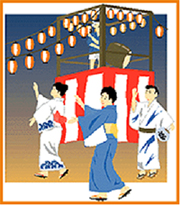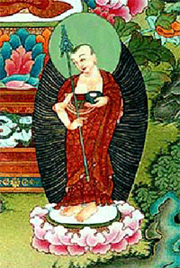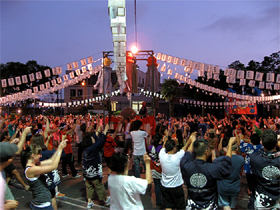

Featured Article of the Month
Obon Festival & Bon Odori
By Mr Naya Reitoku
 |
Obon is one of the most important traditions for Japanese people. It has been celebrated in Japan for more than 500 years, to honour the departed spirits of one's ancestors. People believe that their ancestors' spirits come back to their homes to be reunited with their family during Obon, and so this Buddhist custom has evolved into a family reunion holiday during which people return to ancestral home and clean their ancestors' graves. Also known as the Feast of Lanterns, it traditionally includes a dance, known as Bon-Odori. |
| Bon Odori (盆踊り), which simply means ‘Bon dance’, originated as a Nenbutsu (Buddhist) folk dance to welcome the spirits of the dead. There are various theories about its origin, one of which is about Mokuren, a disciple of Buddha, who used his supernatural powers to look upon his dead mother. When he did this, he discovered she had fallen into the “Realm of Hungry Ghosts” and was suffering. Greatly disturbed, he went to Buddha and asked for advice and was instructed to make offerings to the many Buddhist monks who had just completed their summer retreat, on the fifteenth day of the seventh month. Mokuren carried out Buddha’s advice and thus, saw his mother's release. |  |
| Mokuren, joyful for his mother’s release and grateful to learn that his mother had in fact lived an unselfish and giving life, danced with joy. From this dance of joy comes Bon Odori, a dance to remember and appreciate one’s ancestors and their sacrifices. They are also done to welcome the spirits of the dead. In the course of time, the original religious meaning has faded, and the dance has become associated as a social gathering, where villagers spend a summer night happily dancing to various Bon dances. |
 |
The style of celebration varies in many aspects from region to region. Each region has a local dance, as well as different music. However, anyone can participate in the dance at Obon Festivals. They can just join the circle of dancers that are surrounding a stage (known as yagura) and imitate what others are doing. Usually, taiko drums keep the rhythm during Bon Odori. Some very popular Bon dances are Tanko Bushi, Tokyo Ondo and Soran Bushi. In recent years, anime theme songs and modern songs like Kiyoshi no Zundoko Bushi and Kawachi Otoko Bushi have made their way into Bon Odori. |
| Celebrations at Obon Festivals usually include huge carnivals with rides, games, and summer festival food like watermelon. People also usually wear yukata when attending these festivals. Obon Festival also shares some similarities with other cultures around the world. One of them is the Mexican observance of the Day of the Dead, during which families reunite and care for their ancestors' grave sites. Similarly, the Chinese believe that the gates of Hell open for spirits to return during the Hungry Ghost 7th Month, and people hold prayer sessions to burn offerings including paper money. Obon Festival is also similar to an Indian festival ‘Onam’ taking place in the Indian state of Kerala, a 10-day celebration full of dances and a street carnival commemorating the return of ancestors to earth which also occurs about same period as Obon, during the Indian month Chingam (15 Aug – 15 Sep). |
About the Author
|
Mr Naya Reitoku started to learn traditional Japanese dance in 1988 at the Japanese Cultural Society, Singapore under the tutelage of Ms Hanayagi Jusetsuga. From November 1993 till today, he went under the direct tutelage of Ms Hanayagi Momonosato.
* All photos used in this article are provided by the author / © Mr Naya Reitoku |
|
Japan Creative Centre 4 Nassim Road, Singapore 258372 +65 6737 0434 / jcc@sn.mofa.go.jp http://www.sg.emb-japan.go.jp/JCC Nearest parking at Orchard Hotel & Delphi Orchard |
 |